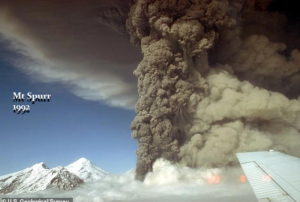The Volatile Nature of Mount Spurr: Insights Into Its Geological History and Eruptive Potential

As we move through 2025, the volcanic activity in Alaska has heightened concerns regarding Mount Spurr, a powerful stratovolcano that looms ominously in the Aleutian Arc. With recent alerts indicating a potential eruption, it’s vital for investors, residents, and geology buffs to understand Mount Spurr’s historical behavior and implications for the future.
Historical Background: Holocene and Pleistocene Eruptions
Mount Spurr is no stranger to volcanic activity. Its most significant eruption, prior to its recorded history, was in 1953, when it displayed a Volcanic Explosivity Index (VEI) of 3. However, geological studies reveal a deeper story. The volcano showcases Holocene eruptions—such as major activity roughly 8,000 to 9,000 years ago, characterized by pyroclastic flows and substantial lava dome formations. These events were revealed through meticulous tephrochronology and radiocarbon dating of volcanic deposits, which serve as both a timeline and a geological narrative of the area.
Interestingly, evidence also hints at earlier, late Pleistocene activity. Though the dates and details are less precise, they inform our understanding of the volcano’s formation and growth over millennia. Importantly, Mount Spurr’s prehistoric eruptions primarily exist as shadows in the geological record, studied through the ash layers that act as a time capsule for archaeologists to piece together the region’s past.
The 1953 and 1992 Eruptions: A Closer Look
The 1953 eruption was historic, producing an ash column that soared to approximately 70,000 feet. Despite its explosive nature, with approximately 0.021 km³ of tephra ejected, it remained within the bounds of a VEI 3.
Fast forward to 1992, when Mount Spurr demonstrated its capability for more powerful eruptions. This event was categorized as VEI 3 to VEI 4, with a significantly greater tephra volume of 0.055 km³ and an ash plume reaching 14 km. Understanding these distinctions is critical for assessing future risks, as VEI scores consider both eruptive material and secondary factors like plume height and duration.
Patterns and Predictions: What Lies Ahead for Mount Spurr?
With scientific observations pointing to a possible eruption, many question whether Mount Spurr is building towards another significant event. Drawing from volcanic action and eruption cycles, it could be argued that patterns from the past provide a roadmap for understanding potential future behavior. The previous eruptions exhibit cycles of approximately 72 years, suggesting we could see heightened activity in 2025, following this cycle from the 1953 event.
While a VEI 3 or VEI 4 eruption seems plausible for this year, forecasts indicate that a larger event, perhaps even exceeding VEI 5, could unfold by 2031 or 2032. History suggests that we are at the cusp of a significant shift, as the geological mechanisms that trigger eruptions can be cyclical in nature.
Why Understanding the VEI Matters
The Volcanic Explosivity Index serves as a crucial metric for gauging the impact of eruptions. Each VEI level represents about a tenfold increase in erupted material. For context, while a VEI 3 eruption is a powerful local event, a VEI 5 can significantly influence global climate, as seen with historical examples:
- VEI 7: The cataclysmic Tambora eruption in 1815 released 160 km³ of ash, leading to a dramatic drop in global temperatures, famously resulting in the Year Without a Summer in 1816.
- VEI 6: Pinatubo’s eruption in 1991 injected 10 km³, leading to a 0.5°C global cooling.
- VEI 5: The Mount St. Helens eruption in 1980, while devastating at a local level, released 1 km³ without climate impact.
Conclusion: Keeping a Close Eye on Mount Spurr
At the Extreme Investor Network, we believe that understanding the geological phenomena such as Mount Spurr is vital for both risk management and investment strategies. The future may be uncertain, but armed with knowledge from historical patterns and geological data, individuals, investors, and businesses can prepare for potential challenges ahead.
Stay tuned to our blog for the latest updates and insights on volcanic activity and its implications for investment and our ever-evolving landscape. Do you want to learn more about how geological events intersect with investment opportunities? Subscribe to our newsletter to get exclusive insights directly from our team of experts!

